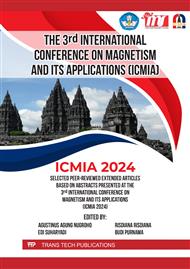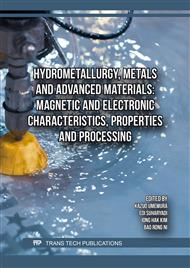p.41
p.53
p.59
p.69
p.77
p.87
p.95
p.105
p.111
Synthesis of Fe3O4 and Fe2O3 Nanocrystal from Iron Sand with Semi-Automatic Coprecipitator
Abstract:
Fe3O4 and Fe2O3 nanocrystals have been successfully synthesized from iron sand by the coprecipitation method using a semi-automatic coprecipitator. The composition of iron sand used was 12, 18, and 24 gram, to investigate the performance of the coprecipitator. The synthesized Fe3O4 and Fe2O3 nanocrystals were characterized using X-Ray Diffraction (XRD), Scanning Electron Microscopy-Energy Dispersive X-Ray (SEM-EDX), and Vibrating Sample Magnetometer (VSM). The best phase composition of Fe3O4 nanocrystals is 100 wt% which has a magnetite crystal size range of 5 to 13 nm, and the mass obtained is in the range of 7.01 to 12.71 gram. The best phase composition of Fe2O3 nanocrystals is 99.89 wt% hematite (α – Fe2O3) which has a crystal size range of 23 to 26 nm, the mass obtained is in the range of 3.51 to 7.49 gram. The highest gain of Fe3O4 and Fe2O3 nanocrystals was 67.62% and 41.58%, respectively, obtained from 18 gram iron sand composition. The morphology of Fe3O4 and Fe2O3 nanocrystals is almost spherical. The highest magnetization was obtained from Fe3O4 nanocrystals with a saturation magnetization of 8.87 emu/gram. The magnetic properties of Fe3O4 and Fe2O3 nanocrystals are ferrimagnetic and weak ferrimagnetic, respectively.
Info:
Periodical:
Pages:
111-117
Citation:
Online since:
June 2025
Price:
Сopyright:
© 2025 Trans Tech Publications Ltd. All Rights Reserved
Share:
Citation:



